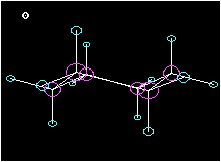
Back نموذج الكرة والعصا Arabic Model štap i lopta BS Model de barres i boles Catalan Stäbchenmodell German Pilko-bastoneta modelo EO Modelo de barras y esferas Spanish مدل گلوله و میله FA Modèle moléculaire boules-bâtonnets French דגם כדור-מקל HE Modello ad asta e sfera Italian
This article has multiple issues. Please help improve it or discuss these issues on the talk page. (Learn how and when to remove these messages)
|

In chemistry, the ball-and-stick model is a molecular model of a chemical substance which displays both the three-dimensional position of the atoms and the bonds between them.[1] The atoms are typically represented by spheres, connected by rods which represent the bonds. Double and triple bonds are usually represented by two or three curved rods, respectively, or alternately by correctly positioned sticks for the sigma and pi bonds. In a good model, the angles between the rods should be the same as the angles between the bonds, and the distances between the centers of the spheres should be proportional to the distances between the corresponding atomic nuclei. The chemical element of each atom is often indicated by the sphere's color.[2]
In a ball-and-stick model, the radius of the spheres is usually much smaller than the rod lengths, in order to provide a clearer view of the atoms and bonds throughout the model. As a consequence, the model does not provide a clear insight about the space occupied by the model. In this aspect, ball-and-stick models are distinct from space-filling (calotte) models, where the sphere radii are proportional to the Van der Waals atomic radii in the same scale as the atom distances, and therefore show the occupied space but not the bonds.

Ball-and-stick models can be physical artifacts or virtual computer models. The former are usually built from molecular modeling kits, consisting of a number of coil springs or plastic or wood sticks, and a number of plastic balls with pre-drilled holes. The sphere colors commonly follow the CPK coloring. Some university courses on chemistry require students to buy such models as learning material.
- ^ Turner M (1971). "Ball and stick models for organic chemistry". Journal of Chemical Education. 48 (6): 407. Bibcode:1971JChEd..48..407T. doi:10.1021/ed048p407.
- ^ Olmsted J, Williams GM (1997). Chemistry: The Molecular Science. Jones & Bartlett Learning. p. 87. ISBN 978-0-8151-8450-8.